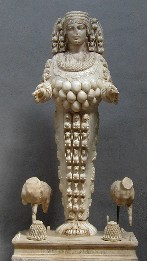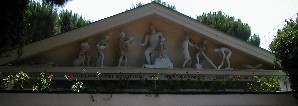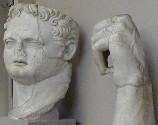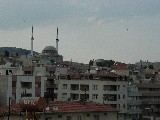Bergama, Turkey, Saturday morning, 16 June 2001
Thursday was a fairly relaxing day: I dropped off Stas at the hamam (Turkish bath) in Bodrum while I took the children to an American chain fast-food restaurant such as they still love; and there was swimming at Bitez Beach both before and afterwards. Then Friday we headed north again.

 Along the way here we repaired our earlier omission of the museum in Selçuk, containing many of the finds from nearby Ephesus. (The town of Selçuk is the current successor to Ephesus, founded in the sixth century or so A.D.) Pride of place here goes to two human-life-size cult figures of Artemis of the Ephesians, relatively well preserved because lovingly buried by some ancient devoté, in a successful attempt to hide and protect them from the rising tide of Christian intolerance and violence against the vestiges of Hellenic religion. Here we see no mere daughter of Zeus and sister of Apollo, no tomboyish virginal slip of a girl with a hunting bow, but an Artemis richly and majestically partaking of some shadowy cult predating the Olympian religion altogether. Both show the goddess in the same pose, with her clothing crowded with animal images, and a strange triple row of breasts, eggs, fruits, or possibly even testicles about her middle (similar appendages have been found adorning an image of Zeus). That on the left features a zodiacal necklace, while that on the right features a crown representing the city.
Along the way here we repaired our earlier omission of the museum in Selçuk, containing many of the finds from nearby Ephesus. (The town of Selçuk is the current successor to Ephesus, founded in the sixth century or so A.D.) Pride of place here goes to two human-life-size cult figures of Artemis of the Ephesians, relatively well preserved because lovingly buried by some ancient devoté, in a successful attempt to hide and protect them from the rising tide of Christian intolerance and violence against the vestiges of Hellenic religion. Here we see no mere daughter of Zeus and sister of Apollo, no tomboyish virginal slip of a girl with a hunting bow, but an Artemis richly and majestically partaking of some shadowy cult predating the Olympian religion altogether. Both show the goddess in the same pose, with her clothing crowded with animal images, and a strange triple row of breasts, eggs, fruits, or possibly even testicles about her middle (similar appendages have been found adorning an image of Zeus). That on the left features a zodiacal necklace, while that on the right features a crown representing the city.

 This first-century-B.C. sculptural group from the Pollio fountain in Ephesus depicts Odysseus offering wine to Polyphemus while his companions sharpen a stake to blind the brute. Scanty originals are shown left; the outdoor pediment on the right is a fuller reconstruction, with the darker portions corresponding to the surviving fragments.
This first-century-B.C. sculptural group from the Pollio fountain in Ephesus depicts Odysseus offering wine to Polyphemus while his companions sharpen a stake to blind the brute. Scanty originals are shown left; the outdoor pediment on the right is a fuller reconstruction, with the darker portions corresponding to the surviving fragments.
 The original head of Polyphemus from this group, though much eroded, seems to follow Homer in largely ignoring the Cyclops' most notorious peculiarity.
The original head of Polyphemus from this group, though much eroded, seems to follow Homer in largely ignoring the Cyclops' most notorious peculiarity.

 At left, a relief from an inner frieze of the temple of Hadrian, depicting the mythic founder of the city in mounted pursuit of a wild pig (part of the fulfillment of an oracle specifying where he should found the city). At right, a colossal head and fist of Domitian, of which the former though not the latter makes him look rather like a colossal baby. Perhaps he was, at that: a baby's head owning and directing a man's fist is an apt metaphor for all too many a Caesar.
At left, a relief from an inner frieze of the temple of Hadrian, depicting the mythic founder of the city in mounted pursuit of a wild pig (part of the fulfillment of an oracle specifying where he should found the city). At right, a colossal head and fist of Domitian, of which the former though not the latter makes him look rather like a colossal baby. Perhaps he was, at that: a baby's head owning and directing a man's fist is an apt metaphor for all too many a Caesar.
On our way to Bergama we failed to escape in time to a bypass and got badly lost in the middle of Izmir (Smyrna). Just as we finally found our way out of the central district towards the road to Çanakkale, I recognized our way out as the same we had come in on.

 Our hotel here has a pool on the roof, from which one can look out over the distinctively Turkish skyline, a combination of mosque domes and minarets with solar water heaters and satellite dishes.
Our hotel here has a pool on the roof, from which one can look out over the distinctively Turkish skyline, a combination of mosque domes and minarets with solar water heaters and satellite dishes.
previous entry
next entry
main/ToC page

 Along the way here we repaired our earlier omission of the museum in Selçuk, containing many of the finds from nearby Ephesus. (The town of Selçuk is the current successor to Ephesus, founded in the sixth century or so A.D.) Pride of place here goes to two human-life-size cult figures of Artemis of the Ephesians, relatively well preserved because lovingly buried by some ancient devoté, in a successful attempt to hide and protect them from the rising tide of Christian intolerance and violence against the vestiges of Hellenic religion. Here we see no mere daughter of Zeus and sister of Apollo, no tomboyish virginal slip of a girl with a hunting bow, but an Artemis richly and majestically partaking of some shadowy cult predating the Olympian religion altogether. Both show the goddess in the same pose, with her clothing crowded with animal images, and a strange triple row of breasts, eggs, fruits, or possibly even testicles about her middle (similar appendages have been found adorning an image of Zeus). That on the left features a zodiacal necklace, while that on the right features a crown representing the city.
Along the way here we repaired our earlier omission of the museum in Selçuk, containing many of the finds from nearby Ephesus. (The town of Selçuk is the current successor to Ephesus, founded in the sixth century or so A.D.) Pride of place here goes to two human-life-size cult figures of Artemis of the Ephesians, relatively well preserved because lovingly buried by some ancient devoté, in a successful attempt to hide and protect them from the rising tide of Christian intolerance and violence against the vestiges of Hellenic religion. Here we see no mere daughter of Zeus and sister of Apollo, no tomboyish virginal slip of a girl with a hunting bow, but an Artemis richly and majestically partaking of some shadowy cult predating the Olympian religion altogether. Both show the goddess in the same pose, with her clothing crowded with animal images, and a strange triple row of breasts, eggs, fruits, or possibly even testicles about her middle (similar appendages have been found adorning an image of Zeus). That on the left features a zodiacal necklace, while that on the right features a crown representing the city.






